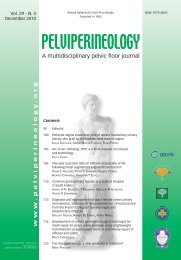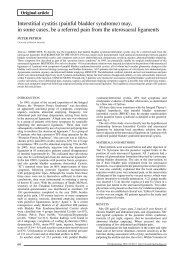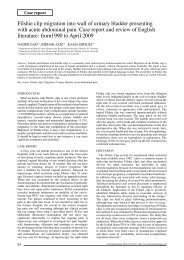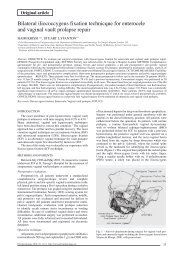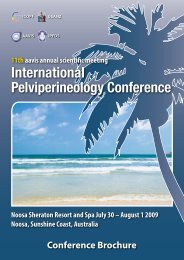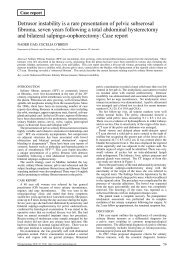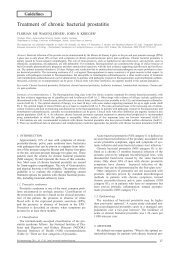This Issue Complete PDF - Pelviperineology
This Issue Complete PDF - Pelviperineology
This Issue Complete PDF - Pelviperineology
Create successful ePaper yourself
Turn your PDF publications into a flip-book with our unique Google optimized e-Paper software.
Original article<br />
A preliminary report on the use of a partially absorbable mesh<br />
in pelvic reconstructive surgery<br />
ACHIM NIESEL (*) - OLIVER GRAMALLA (**) - AXEL ROHNE (*)<br />
(*) Klinik Preetz, Department for Obstetrics and Gynecology, 24211 Preetz, Germany,<br />
(**) SERAG-WIESSNER KG, Zum Kugelfang 8-12, 95119 Naila, Germany<br />
Abstract: The physical characteristics of a synthetic implant used in pelvic reconstructive surgery are thought to play an important role in<br />
the causation of erosion and other complications of mesh implantation. <strong>This</strong> is in addition to the significant role of surgical technique and a<br />
patient’s own risk factors. In this report the physical characteristics of non reabsorbable and partially reabsorbable meshes are examined and<br />
compared including weight, breaking strength, flexural rigidity and pore size. A preliminary study is reported where thirty patients underwent<br />
prolapse surgery with bilateral sacrotuberal fixation of the vault and mesh implants in the anterior and/or posterior vaginal wall using a partially<br />
reabsorbable mesh. Mean follow- up at 1 year demonstrated an erosion rate of 4-4.5% with a recurrence rate only in the anterior compartment<br />
of 12%.<br />
Key words: Pelvic reconstructive surgery; Mesh erosion; Partially absorbable mesh.<br />
INTRODUCTION<br />
Conventional procedures for reconstructive vaginal surgery<br />
are burdened with recurrence rates of up to 30%. 1, 2<br />
Many of these operations can result in a poor anatomical<br />
result and loss of the physiological vaginal axis. <strong>This</strong> may<br />
lead to secondary pelvic defects and functional pelvic problems.<br />
Since the introduction of mesh in pelvic organ prolapse<br />
(POP) surgery good anatomical restoration appears to<br />
be associated with lower recurrence rates and good functional<br />
outcome. Polypropylene tapes have proven to have<br />
good biocompatibility in vaginal tissues, 3 but there are complications<br />
such as mesh erosion and extrusion.<br />
In 2005 the International Urogynaecology Association<br />
(IUGA) Grafts Roundtable proposed a classification of<br />
simple and complex healing abnormalities 4 which differentiates<br />
between them based on the timing of presentation<br />
relative to implantation, site of the lesion relative to suture<br />
line, the presence of inflammatory tissue and whether there<br />
are any affected viscera. Clinical experience has shown that<br />
most cases of erosion or extrusion are simple healing abnormalities.<br />
The density of graft material and other physical<br />
characteristics like pore size may play a significant role<br />
in tissue acceptance of mesh. Partially absorbable meshes<br />
have the advantage of weight reduction after resorption of a<br />
component of the graft. The aim of this retrospective study<br />
was to demonstrate the efficacy and safety of a partially<br />
absorbable polypropylene / polyglycolacid / -caprolacton<br />
mesh in pelvic reconstructive surgery especially in regard to<br />
the incidence of mesh erosion. We also describe the physical<br />
characteristics of this graft material in comparison to non<br />
absorbable meshes that are currently available.<br />
MATERIALS AND METHODS<br />
Between September 2006 and February 2007, a series of<br />
30 consecutive patients underwent surgery for vaginal prolapse.<br />
The International Continence Society (ICS) Pelvic<br />
Organ Prolapse Quantification (POP-Q) staging system was<br />
used to assess the severity of pelvic organ prolapse. 5 All<br />
patients reported in this study were assessed as POPQ Stage<br />
3 or Stage 4. Tension-free placement of a partially absorbable<br />
mesh beneath the bladder or between the vagina and<br />
rectum was performed using a vaginal approach. The anterior<br />
transobturator mesh (ATOM) repair was performed in<br />
25 of the 30 patients, while 22 underwent posterior graft<br />
implantation and all 30 underwent bilateral sacrotuberal fixation.<br />
In 13 cases a concomitant hysterectomy was done for<br />
22<br />
uterine prolapse POPQ Stage 2 or 3. Seventeen patients had<br />
a post-hysterectomy prolapse and 6 had suffered a recurrence<br />
following a traditional colporrhaphy. Mean age of<br />
patients was 68.5 yrs (range 53-80) with mean parity of 2.3<br />
(range 1-8). After an interval of 2 weeks and again at a mean<br />
follow-up at 1 year (range 10-14 months) the patients were<br />
reassessed.<br />
The surgical procedure involved a transvaginal placement<br />
of a mesh in areas of vesicovaginal and rectovaginal dissection<br />
according to the description of Fischer. 6 In the posterior<br />
compartment a posterior vertical midline incision enabled<br />
the vagina to be dissected from the underlying tissues and<br />
the rectum separated from the vagina. The pararectal fossa<br />
was opened on each side. On each side 2 to 3 non resorbable<br />
sutures were fixed at the sacrotuberal ligament. The<br />
posterior mesh (SeraGYN ® PFI, SERAG- WIESSNER, Germany)<br />
was cut to measure 6-8 cm in width and 10-15 cm<br />
in length. The upper part of the graft was attached to the<br />
vault and the sacrotuberal ligaments with the prefixed non<br />
resorbable sutures. The lateral edges of the mesh were fixed<br />
to the levator ani muscle and the lower edge to the perineum<br />
without tension. In this way a new rectovaginal septum with<br />
vault suspension by bilateral sacrotuberal fixation was performed.<br />
When performing an anterior prolapse mesh procedure<br />
the bladder was dissected free from the vagina following<br />
an anterior vertical midline incision. The paravesical fossa<br />
was opened on each side. Bilateral transobturator passage of<br />
the trapezoid, four-armed mesh (Seratom ® A PA, SERAG-<br />
WIESSNER, Germany) through the arcus tendineus fasciae<br />
pelvis was performed using the anterior transobturator mesh<br />
(ATOM) technique. The upper edge of the implant was<br />
attached to the sacrotuberal ligaments using sacrotuberal<br />
prefixed non resorbable sutures. A new vesicovaginal<br />
septum was thus created with bilateral sacrotuberal vault<br />
suspension.<br />
The partially absorbable mesh consists of polypropylen<br />
(PP), polyglycolacid (PGA) and -caprolacton (PCL) as<br />
components of a monofilament thread. Six filaments of PP<br />
are coated with a co-polymer of PGA and PCL (Fig. 1 ). The<br />
distance between the PP-filaments is > 10 m.<br />
After 120 days PGA and PCL are absorbed and the multifilament<br />
character of the six PP- fibres appears (Fig. 2).<br />
The physical characteristics of the partially absorbable<br />
mesh are compared with three other frequently used grafts:<br />
• Prolift ® , GYNECARE, Johnson & Johnson, New Jersey,<br />
USA;<br />
<strong>Pelviperineology</strong> 2008; 27: 22-25 http://www.pelviperineology.org



